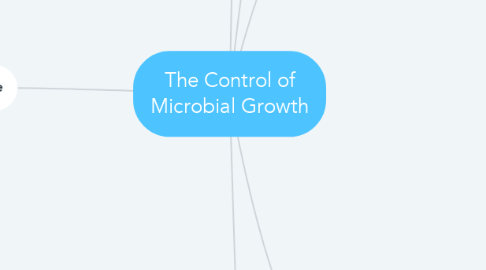
1. Reference
1.1. Tortora, J. G. (2013). Fundamentals of Microbiology (9th ed.). Retrieved from file:///C:/Users/rafae/Downloads/Microbiology%20-%20An%20Introduction%20(11th%20Ed).pdf
2. Physical Methods of Microbial Control
2.1. Heat
2.1.1. Moist heat
2.1.1.1. Boiling
2.1.1.1.1. Protein denaturation
2.1.1.2. Autoclaving
2.1.1.2.1. Protein denaturation
2.1.2. Pasteurization
2.1.2.1. Protein denaturation
2.1.3. Dry heat
2.1.3.1. Direct flaming
2.1.3.1.1. Burning contaminants to ashes
2.1.3.2. Incineration
2.1.3.2.1. Burning to ashes
2.1.3.3. Hot-air sterilization
2.1.3.3.1. Oxidation
2.2. Filtration
2.2.1. Separation of bacteria from suspending liquid
2.3. Cold
2.3.1. Refrigeration
2.3.1.1. Decreased chemical reactions and possible changes in proteins
2.3.2. Deep-freezing
2.3.2.1. Decreased chemical reactions and possible changes in proteins
2.3.3. Lyophilization
2.3.3.1. Decreased chemical reactions and possible changes in proteins
2.4. High Pressure
2.4.1. Alteration of molecular structure of proteins and carbohydrates
2.5. Desiccation
2.5.1. Disruption of metabolism
2.6. Osmotic Pressure
2.6.1. Plasmolysis
2.7. Radiation
2.7.1. Ionizing
2.7.1.1. Destruction of DnA
2.7.2. Nonionizing
2.7.2.1. Damage to DnA
3. Chemical Methods of Microbial Control
3.1. Phenol and Phenolics
3.1.1. Phenol
3.1.1.1. Disruption of plasma membrane, denaturation of enzymes
3.1.2. Phenolics
3.1.2.1. Disruption of plasma membrane, denaturation of enzymes
3.1.3. Bisphenols
3.1.3.1. Probably disruption of plasma membrane
3.2. Biguanides
3.2.1. Disruption of plasma membrane
3.3. Halogens
3.3.1. Iodine
3.3.1.1. Inhibits protein function and is a strong oxidizing agent
3.3.2. Chlorine
3.3.2.1. Alters cellular components
3.4. Alcohols
3.4.1. Protein denaturation and lipid dissolution
3.5. Heavy Metals and Their Compounds
3.5.1. Denaturation of enzymes and other essential proteins
3.6. Surface-Active Agents
3.6.1. Soaps and detergents
3.6.1.1. Mechanical removal of microbes through scrubbing
3.6.2. Acid-anionic sanitizers
3.6.2.1. Enzyme inactivation or disruption.
3.6.3. Quaternary ammonium compounds
3.6.3.1. Enzyme inhibition, protein denaturation, and disruption of plasma membranes
3.7. Chemical Food Preservatives
3.7.1. Organic acids
3.7.1.1. Metabolic inhibition
3.7.2. Nitrates/nitrites
3.7.2.1. Inhibits certain iron-containing enzymes of anaerobes
3.8. Aldehydes
3.8.1. Protein denaturation
3.9. Chemical Sterilization
3.9.1. Ethylene oxide and other gaseous sterilants
3.9.1.1. Inhibits vital cellular functions
3.9.2. Plasma sterilization
3.9.2.1. Inhibits vital cellular functions
3.9.3. Supercritical fluids
3.9.3.1. Inhibits vital cellular functions
3.10. Peroxygens and Other Forms of Oxygen
3.10.1. Oxidation
4. Terminology
4.1. Sterilization
4.1.1. Destruction of all forms of microbial life
4.2. Disinfection
4.2.1. Destruction of vegetative pathogens
4.3. Antisepsis
4.3.1. Destruction of pathogens on living tissue
4.4. Degerming
4.4.1. Removal of microbes from a limited area
4.5. Sanitization
4.5.1. Lower microbial counts on eating and drinking utensils
4.6. Biocide
4.6.1. Kills microorganisms
4.6.1.1. Fungicide
4.6.1.1.1. Kills fungi
4.6.1.2. Virucide
4.6.1.2.1. Inactivates viruses
4.7. Bacteriostasis
4.7.1. Inhibit the growth and multiplication of bacteria
4.8. Asepsis
4.8.1. Absence of significant contamination
4.9. Sepsis
4.9.1. Bacterial contamination
5. The Rate of Microbial Death
5.1. Factors that influence the effectiveness of antimicrobial treatments
5.1.1. Number of microbes
5.1.2. Environmental influences
5.1.3. Time of exposure
5.1.4. Microbial characteristics
